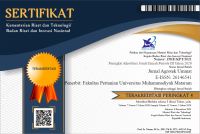KANDUNGAN KOPI KEDELAI LAUWON KECAMATAN LUWUK TIMUR KABUPATEN BANGGAI
Abstract
Soybean is an ingredient that has many benefits and is informed that it does not contain caffeine, so it is good and safe for consumption by children, pregnant women, and people who have digestive diseases. This study aims to determine the content of soy coffee produced by the people of Lauwon Village, East Luwuk District, Banggai Regency, Central Sulawesi Province. This research was conducted from April to August 2020 which consisted of 2 stages, namely: 1) the first stage, the manufacture of soy coffee which was carried out by the people of Lauwon Village, Luwuk Timur District, Banggai Regency, Central Sulawesi Province. 2) the second stage, laboratory testing at the Integrated Research and Testing Laboratory (LPPT) UGM Yogyakarta. The results showed that Lauwon soybean coffee does not contain caffeine (non-caffeine) and contains water content (3.42%), protein (31.26%), total fat (0.95%), total sugar (0.50%). ), lead (Pb) was not detected, copper (Cu) (13.97 mg / kg), zinc (Zn) (52.99 mg / kg), mercury (Hg) 0.04 mg / kg, bacterial contamination rate ( ALT) 2.0 x 103 cfu / gram and DPPH free radical scavenging activity (IC50) 2.467 mg / mL.
Keywords
Full Text:
PDFReferences
Badarinath, A. V et al. (2010) ‘A review on in-vitro antioxidant methods: comparisions, correlations and considerations’, International Journal of PharmTech Research, 2(2), pp. 1276–1285.
Baroroh, F. (2017) ‘Fitoremediasi Air Tercemar Tembaga (Cu) Menggunakan Salvinia molesta Dan Pistia stratiotes Serta Pengaruhnya Terhadap Budidaya Tanaman Brassica rapa’. Universitas Brawijaya.
Bawazeer, N. A. and AlSobahi, N. A. (2013) ‘Prevalence and side effects of energy drink consumption among medical students at Umm Al-Qura University, Saudi Arabia’, International Journal of Medical Students
(3), pp. 104–108.
Bokhari, S. H. et al. (2016) ‘Phytoremediation potential of Lemna minor L. for heavy metals’, International journal of phytoremediation. Taylor & Francis, 18(1), pp. 25–32.
Irawanto, R. (2010) ‘Fitoremidiasi Lingkungan Dalam Taman Bali’, Local Wisdom: Jurnal Ilmiah Kajian Kearifan Lokal, 2(4), pp. 29–35.
Juhriah, J. and Alam, M. (2016) ‘Fitoremediasi Logam Berat Merkuri (Hg) pada Tanah Dengan Tanaman Celosia Plumosa (Voss) Burv.’, BIOMA: JURNAL BIOLOGI MAKASSAR, 1(1).
Küçer, N. (2010) ‘The relationship between daily caffeine consumption and withdrawal symptoms: a questionnaire-based study’, Turkish Journal of Medical Sciences. The Scientific and Technological Research Council of Turkey, 40(1), pp. 105–108.
Megananda, R. C., Arlianni, K. W. and Mawardani, N. A. (2019) ‘DIVERSIVIKASI KOPI BIJI MENGKUDU (Morinda citrifolia) SEBAGAI UPAYA PELESTARIAN TANAMAN LOKAL’, in Prosiding Seminar Nasional SIMBIOSIS.
Mudjisihono (2000) ‘Teknologi Pengolahan Bubuk Kedelai sebagai Minuman. Liptan.’, 141(74).
Mudjisihono (2001) ‘PENGOLAHAN BUBUK KEDELAI SEBAGAI BAHAN MINUMAN ALTERNATIF’, Balai Pengkajian Teknologi Pertanian Jogjakarta.
Nainggolan, R. et al. (2018) ‘Pengolahan Air Limbah Domestik dengan menggunakan Tanah Gambut dan Tanaman Air’, Jurnal Teknik dan Ilmu Komputer, 7(26), pp. 183–189.
Norton, T. R., Lazev, A. B. and Sullivan, M. J. (2011) ‘The “buzz” on caffeine: Patterns of caffeine use in a convenience sample of college students’, Journal of caffeine research. Mary Ann Liebert, Inc. 140 Huguenot Street, 3rd Floor New Rochelle, NY 10801 USA, 1(1), pp. 35–40
Novita, E., Hermawan, A. A. G. and Wahyuningsih, S. (2019) ‘Komparasi Proses Fitoremediasi Limbah Cair Pembuatan Tempe menggunakan Tiga Jenis Tanaman Air’, Jurnal Agroteknologi, 13(01), pp. 16–24
Purakayastha, T. J. and Chhonkar, P. K. (2010) ‘Phytoremediation of heavy metal contaminated soils’, in Soil heavy metals. Springer, pp. 389–429
Rahmawati, A., Zaman, B. and Purwono, P. (2016) ‘Kemampuan Tanaman Kiambang (Salvinia Molesta) dalam Menyisihkan Bod dan Fosfat pada Limbah Domestik (Grey Water) dengan Sistem Fitoremediasi secara Kontinyu’. Diponegoro University.
Riswan, R., Harun, U. and Irsan, C. (2015) ‘Keragaman Flora Di Lahan Reklamasi Pasca Tambang Batubara PT Ba Sumatera Selatan (Flora Diversity at Post-coal Mining Reclamation in the PT Ba South Sumatera)’, Jurnal Manusia dan lingkungan, 22(2), pp. 160–168.
Rondonuwu, S. B. (2014) ‘Fitoremediasi limbah merkuri menggunakan tanaman dan sistem reaktor’, Jurnal Ilmiah Sains, 14(1), pp. 52–59.
Setiavani, G. and di STPP Medan, M. P. S. P. (2012) ‘INOVASI PEMBUATAN SUSU KEDELE TANPA RASA LANGU’.
Sidauruk, L. and Sipayung, P. (2015) ‘Fitoremediasi lahan tercemar di kawasan industri Medan dengan tanaman hias’, Pertanian Tropik. University of North Sumatra, 2(2), p. 157093.
Singh, T. and Singh, D. K. (2017) ‘Phytoremediation of organochlorine pesticides: Concept, method, and recent developments’, International journal of phytoremediation. Taylor & Francis, 19(9), pp. 834–843.
Sofiana, N. (2011) ‘1001 Fakta Tentang Kopi’, Yogyakarta: Cahaya Atma Pustaka.
Sofwan, R. (2013) Bugar Selalu di Tempat Kerja. Bhuana Ilmu Populer.
Suharto, B., Wirosoedarmo, R. and Sulanda, R. H. (2018) ‘Pengolahan Limbah Batik Tulis dengan Fitoremediasi Menggunakan Tanaman Eceng Gondok (Eichornia crassipes)’, Jurnal Sumberdaya Alam dan Lingkungan, 3(1), pp. 14–19.
Yu, X. et al. (2013) ‘Adsorption of heavy metal ions from aqueous solution by carboxylated cellulose nanocrystals’, Journal of Environmental Sciences. Elsevier, 25(5), pp. 933–943.
Zhuang, P. et al. (2013) ‘Heavy metal contamination in soil and soybean near the Dabaoshan Mine, South China’, Pedosphere. Elsevier, 23(3), pp. 298–304
DOI: https://doi.org/10.31764/jau.v7i2.2883
Refbacks
- There are currently no refbacks.
Copyright (c) 2020 Author(s)

This work is licensed under a Creative Commons Attribution-ShareAlike 4.0 International License.

 |  |  |  |
| |||
 |  |  |
|
POSTAL ADDRESS












